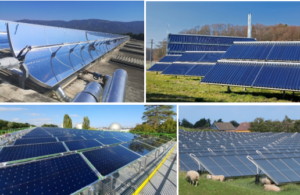“There is an unbeatable Cost-Effectiveness“
August 10, 2009
 Volker Kallwellis, head of development department at Wagner & Co Solartechnik, Cölbe, Germany published the following statement in the international magazine Sun & Wind Energy 7/2009 about the advantages of flat plate collectors. Photo: Wagner & Co
Volker Kallwellis, head of development department at Wagner & Co Solartechnik, Cölbe, Germany published the following statement in the international magazine Sun & Wind Energy 7/2009 about the advantages of flat plate collectors. Photo: Wagner & Co
“Until two years ago we also had vacuum tube collectors in our range. Because of the high performance of our flat plate collectors, the demand we had for vacuum tube collectors declined steadily. Plus, the use of vacuum tube technology requires a significantly higher technical effort and has regularly been linked to various problems in the past. From 2007 onwards we took the product out of our range completely and are now concentrating solely on flat plate collectors. We can list a number of reasons for this:
- Flat plate collectors have a better price-to-performance ratio for hot water systems and for heating support. The specific yield increase for vacuum tube collectors per square metre can be generated more cheaply by using a larger area of flat plate collectors.
- Flat plate collectors are robust, long-lasting, low in maintenance and are fairly forgiving of certain installation errors, whereas tube collectors have a series of technical disadvantages during installation and operation that can also lead to larger problems – e.g. very high stagnation temperatures. As a result, the heat carrier fluid ages faster and must be checked and replaced more often. If there are often periods of stagnation and maintenance is not carried out, then in some tube types – mainly those with poor drainage characteristics and small tube cross-sections – the heat transfer fluid degrades and leaves tar-like blockages in the absorber tubes. The collector is then unusable. Purely water-based systems do not have this problem. Here there is the danger, however, that temperatures below freezing can destroy the whole collector field if active safety systems, such as the heating of the collectors in winter, fail through a blackout, faulty parts or incorrect use. The sun shining on the collectors before they go into operation also tends not to be a problem for flat plate collectors, even over a period of weeks, whereas tube collectors quickly suffer from considerable corrosion and damage to the inner copper tubing.
- Unlike flat plate collectors, tube collectors do not use pre-stressed safety glass. This makes their use in façades and on sloping roofs questionable. If glass tubes break, there is a considerable risk of injury from falling glass shards and larger pieces: in the worst case scenario even “spears of glass”. And it is known that glass breakage can occur even without further mechanical loading through minimal previous damage or construction faults. Hailstorms have also caused considerable damage to glass vacuum tubes again and again in the past, something which just doesn’t happen to this extent with flat plate collectors.
Tube collectors with CPC reflectors often lose performance over time. The cause: a dimming of the reflector through dirt and corrosion, as well as moss growth on the rear of the working tubes through condensation and droplet formation. It is undisputed that vacuum tube technology can play its advantage of having lower heat losses at temperatures of around 70°C and above. However, the main yields for service water heating and heating support are obtained at considerably lower temperatures, so that a better cost-effectiveness can generally be achieved for these uses with flat plate collectors. Serious economic comparisons should take into account all costs and yields, as well as the amount of solar coverage which can be achieved, though.”
Volker Kallwellis, Wagner & Co Solartechnik


